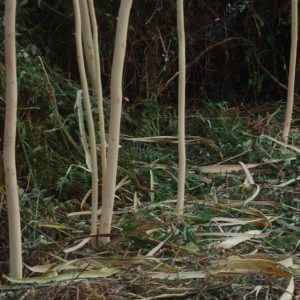Saturday 27th July 2024.

A pocketknife can be a friendly companion in the forest of Monchique. Monchique is a village in the mountain range of the same name in south-west Portugal, at the beginning or end of Europe – it all depends on which way you look at it.
Portugal, and the Monchique Mountains in particular, are known for their cork-oak and chestnut forests. Generally speaking, that was still the case only a generation or so ago, in 1990. Then along came the paper industry and the private owners of these forests began to cut down their forests and plant eucalyptus monocultures instead. In 1990, 82% of all the trees growing in the Monchique region were still native species. As 98% of the so-called forest in Portugal is in private hands and only 2% is state-owned, the profession of a forester, whose task it was to protect both the forest and its fauna, has died out in Portugal. Instead, there is now the ICNF. This institution is supposed to guarantee the protection of the native forest and ensure that no invasive trees or plant species are able to spread over the area (92,090 km2).
The work of the ICNF began with a conflict of interests. Should the Australian eucalyptus tree be declared ‘invasive’ or not? The ICNF was confronted with this question at the end of the 1980s. And it answered the question with a resounding NO. The paper industry had thus achieved exactly what it wanted: the space it needed to grow its resources, a water-absorbing plant. In this way, the alien species known as ‘eucalyptus’ began its triumphant march across the country. Today, around 80% of the forests in the Monchique mountains are monocultures, while as much as 10% of the national territory has been planted with eucalyptus. What was once a highly diverse forest has since given way to a monoculture. Birds do not nest in a monoculture, and no other tree species are able to withstand the intrusive spread of the eucalyptus. Yet this tree should not have been planted, since 92% of the formerly diverse forest in Monchique was placed under the protective umbrella of the ‘Natura 2000’ network and highlighted as a particularly valuable nature area in the maps drawn up by the European Commission in Brussels. However, the ICNF and the local authorities had more important things to do than look after the cork oaks, chestnut trees, lime trees, ash trees, alders and hundreds of other tree species.
Today, there are just five specimens of the black walnut tree left standing in Monchique and three of the original Monchique oak. The money that the sale of eucalyptus has brought to the private forest owners has stifled any criticism of the monocultures. Eucalyptus draws water from the soil; it burns like petrol. These trees are cut down after eight years and then immediately begin to grow back again. Which means that, once every eight years, a eucalyptus tree can be cut down – and then cut down once more, again and again.
It’s a never-ending story. You don’t even have to get your hands dirty…
After more than 30 years, the soil is left completely depleted, at least in those areas where eucalyptus trees grow. The regional groundwater level has fallen drastically during these years of climate change. Many mountain streams have dried up; fish, turtles, fire salamanders and many other animal species have died out within the space of just one generation. However, since we began to plan our new botanical garden, animals have begun to return: the nightingale now sings and raises its young here once more.
Nobody had anticipated the first major forest fire in Monchique in 1991. After that first unexpected nightmare, the forest burned again on 11 September 2003. Yet, because the gigantic fire could not be extinguished, it burned for ten days, during which time it reached all the way down to the sea. And the Monchique forest burned again in 2004 and 2016, once more on 3 August 2018, and then again in 2023. These forest fires cannot be stopped unless they are successfully extinguished at their very beginning. That’s what the fire brigade says.
Extinguishing these fires is one thing, but neither the ICNF nor the town council in Monchique seem to be particularly aware of the other danger that seriously threatens the forest: the acacias and mimosas, the other tree species that were imported to Portugal from south-east Australia in the 1930s, together with the eucalyptus. Both of these invasive trees are, in fact, even more aggressive and even more thirsty for water, since they grow very fast, with both shallow and deep roots. After each forest fire, acacias and mimosas are the first plants to grow back again – immediately. Now, in July/August 2024, it would seem that the mayor Paulo Alves and his closest colleagues are wondering why the region’s springs, mountain streams and water mines have dried up. All he needs to do is get up off his backside, venture forth from his office in the town hall and take a closer look at the forests. Then he would realise that both acacias and mimosa trees are growing wildly in all three parishes of Monchique, Alferce and Marmelete, proliferating, above all, in the beds of the region’s streams, close to their springs and in the water mines. Millions of invasive tree species are taking over Monchique.
And the worst thing of all is that if you fell acacias or mimosas, they grow back immediately, just as the eucalyptus does. Not even a week goes by, and they are immediately sprouting once more. And this is where my pocketknife comes into play. I hunt down invaders with my pocketknife: tree by tree. I peel the bark off their trunks. It’s the only way to condemn them to an eventual death in the eternal hunting grounds. They dry out, and their leaves, branches, trunk and roots die. After about three months, the time comes. I cut the trunk at waist height with my small electric chainsaw and grab hold of what remains in the ground, rocking it back and forth and pulling out the roots very slowly. What you need for this job, apart from a pocketknife, is a lot of patience and trust in the healing powers of nature. Last year, I managed to uproot just over 250 acacias and mimosas. Every day, I visit the corner of the garden that has been cleared, and I will subsequently add a few more native trees to the cork oaks, almond, carob and fig trees growing there. Every day I walk a few laps of the new botanical garden of Caldas de Monchique with my dog Max, keeping a close watch to see how the diversity of the tree population – the new forest – is doing. Water is a scarce commodity and I have to irrigate some of the trees from a watering can almost every evening so that they can gradually grow a little taller. And to protect this diversity, we have installed eight large sprinklers, so that we can now face the next forest fire, albeit with some anxiety, but with a strong sense of defiance. Will it be a happy ending? Let’s wait and see.
P.S.: A week ago, we asked the ICNF if they would like to issue a statement for inclusion in this short story. Our Lisbon colleague visited the ICNF at its head office at No. 16, Avenida da República, and spoke to their press officer, Rita Justo. At the time of going to press, the ICNF has so far been unable to comment on the matter. Perhaps next week?…
 Eco123 Revista da Economia e Ecologia
Eco123 Revista da Economia e Ecologia














